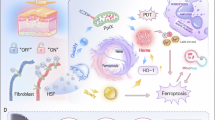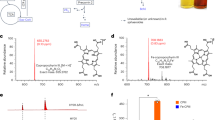Abstract
THE direct action of light on the skin in porphyria is well documented. There is a specific spectral response in that light of wavelengths between 400 nm or 500–600 nm causes lesions through photodynamic action of porphyrin in the skin1–4. Light may however affect abnormal porphyrin metabolism apart from any action on the skin. We noticed that skin lesions were provoked in porphyric rats, whose coats were shaved, by continuous irradiation by white light fluorescent tubes. Some porphyric animals, in which the coat was not shaved off as a control, excreted more porphyrin when under continuous light than other control animals under continuous dark. This implicated light as an environmental factor effecting porphyrin metabolism. Porphyrin excretion as a measure of abnormality, however, gave inconclusive results. Instead we have used the activity of hepatic δ-aminolaevulinic acid synthetase (ALA-S), the rate controlling enzyme in the haem biosynthetic pathway5, as an index of porphyrin abnormality. Normally, ALA-S activity is low, but where porphyria is present clinically or has been induced chemically in experimental animals, activity is raised6. We used 1, 4-dihydro-2, 4, 6-trimethyl pyridine-3, 5-dicarboxylate (DDC) to induce porphyria; this chemical, like some other porphyrinogenic agents, such as griseofulvin, probably acts through interfering with a negative feedback inducing mechanism involving haem7.
This is a preview of subscription content, access via your institution
Access options
Subscribe to this journal
Receive 51 print issues and online access
$199.00 per year
only $3.90 per issue
Buy this article
- Purchase on SpringerLink
- Instant access to full article PDF
Prices may be subject to local taxes which are calculated during checkout
Similar content being viewed by others
References
Riemerschmid, G., and Quin, J. I., Onderstepport J. vet. Sci. Anim. Ind., 17, 89 (1941).
Wiskemann, A., and Wulf, K., Arch. klin. exp. Derm., 209, 454 (1959).
Rimington, C., Magnus, I. A., Ryan, E. A., and Cripps, D. J., Q. Jl Med., 36, 29 (1967).
Magnus, I. A., Roe, D. A., and Bhutani, L. K., J. invest. Derm., 53, 400 (1969).
Granick, S., J. biol. Chem., 241, 1359 (1966).
Granick, S., and Urata, G., J. biol. Chem., 238, 821 (1963).
De Matteis, F., Biochem. J., 139, 52P (1972).
Wurtman, R. J., Rother, W., Altschule, M. D., and Wurtman, J. J., Acta endocr., Copenh., 36, 617 (1961).
Moore, R. Y., Heller, A., Bhatnager, R. K., Wurtman, R. J., and Axelrod, J., Archs Neurol Chicago, 18, 208 (1968).
Klüver, H., Science, 99, 482 (1944).
Nair, V., and Casper, R., Life Sci., 8, 1291 (1969).
Author information
Authors and Affiliations
Rights and permissions
About this article
Cite this article
MAGNUS, I., JANOUSEK, V. & JONES, K. The effect of environmental lighting on porphyrin metabolism in the rat. Nature 250, 504–505 (1974). https://doi.org/10.1038/250504a0
Received:
Revised:
Issue date:
DOI: https://doi.org/10.1038/250504a0
This article is cited by
-
Neonatal exposure to protoporphyrin-activating lighting as a contributing cause of childhood acute lymphocytic leukemia
Cancer Causes and Control (1992)



